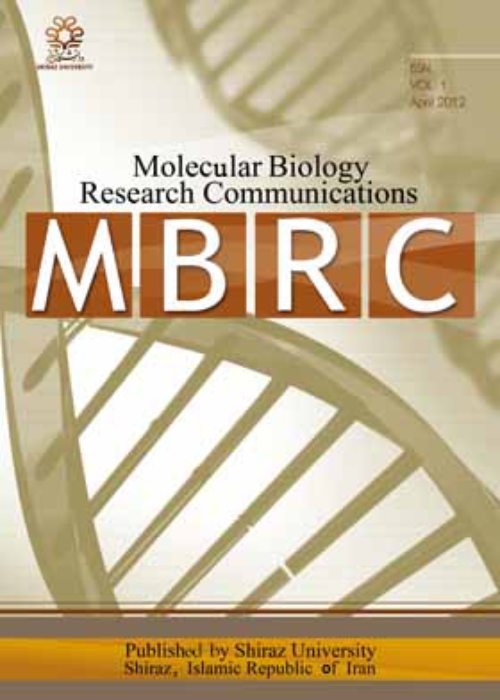فهرست مطالب
Molecular Biology Research Communications
Volume:2 Issue: 1, Mar-Jun 2013
- تاریخ انتشار: 1392/08/10
- تعداد عناوین: 5
-
-
Pages 1-10Due to their mulitpotency, Mesenchymal stem cells (MSCs), have the ability to proliferate and differentiate into multiple mesodermal tissues. The aim of this study was to isolate MSCs from human Umbilical Cord (hUCMSCs) to determine their osteogenic potential on nanofibrous scaffolds. To this end, Poly (L-lactic acid) (PLLA)/Nano hydroxyapatite (HA) composite nanofibrous scaffolds were prepared by electrospinning. The structure and morphology of the scaffolds were investigated using scanning electron microscopy. Human mesenchymal stem cells (MSCs) were isolated from the umbilical cords and cultured in the PLLA/HA scaffold. The viability and proliferation of the cells was then determined by an MTT assay. Cellular adhesion, proliferation and osteogenic differentiation were assessed in these constructs using a range of histological and microscopic techniques. The osteogenesis assays indicated the superiority of nanofibrous scaffolds in supporting MSCs undergoing bone differentiation. Collectively, the bone construct prepared with PLLA/HA scaffold and proliferated MSCs would be a suitable candidate for use in bone regenerative medicine.Keywords: hUCMSCs, Nanofibrous scaffolds, Hydroxyapatite, PLLA, Cell proliferation, Bone differentiation
-
Pages 11-18Propranolol (PL), a non-selective beta-blocker, is a cardiovascular drug widely used to treat hypertension. The present study was concerned with assessing the cytogenetic effects of this drug on Chinese hamster ovary (CHO) cell line. MTT assay was then carried out to determine the cytotoxicity index (IC50) of the drug. The IC50 value of PL was 0.43±0.02 mM. To investigate the clastogenic effects of the drug, chromatid and chromosome breaks and polyploidy in metaphases were analyzed. CHO cells were exposed to different concentrations of the drug (0.1, 0.2, 0.3, 0.4 mM) for 24 hours. Considering that PL has liver metabolism, experiments were carried out in the presence and absence of the metabolic activation system (S9 mix). Mitomycin-C and sodium arsenite were used as positive controls. It was observed that in cells treated with different PL concentrations as 0.1, 0.2 and 0.3 mM, the frequency of chromatid and chromosome breaks as well as polyploidy increased when compared with untreated CHO cells. The addition of S9 mix significantly decreased the chromatid breaks, chromosome breaks and polyploidy compared to the treatment of PL alone. It is concluded that, PL causes chromatid and chromosome aberrations in CHO cell line and the metabolic activation system (S9 mix), playing an important role in drug cytotoxicity reduction.Keywords: Propranolol, Chromatid breakage, Chromosome breakage
-
Pages 19-27The aim of the present study was to assess the frequencies of angiotensin I-converting enzyme (ACE; OMIM: 106180) and methylenetetrahydrofolate reductase (MTHFR; OMIM: 607093) polymorphisms in the Algerian population to further facilitate investigations on possible associations with various pathologies. The study was carried out on 146 apparently healthy individuals (65 males, 81 females) who were randomly selected from an Algerian population of the Setif region (north-eastern Algeria). Their age ranged from 24 to 48 years. Using polymerase chain reaction based methods, genotypic frequencies of MTHFR C677T (rs. 1801133) and ACE I/D (rs. 1799752) polymorphisms were determined. No significant difference was found between genders regarding the distribution of ACE I/D and MTHFR C677T polymorphisms. In general, the prevalence of the D allele of the ACE polymorphism was 70.5%. The study population was in the Hardy Weinberg equilibrium (Chi-Square=0.55, df=1, P=0.758). The allelic frequency of the 67 T allele (for MTHFR C677T polymorphism) was 35.3%. The study population was in the Hardy-Weinberg equilibrium (Chi-Square=1.05, df=1, P=0.304). The surprisingly high incidence of minor alleles of the polymorphisms among our population requires further studies in vascular and other diseases.Keywords: ACE, Algerian Population, MTHFR, Polymorphism
-
Pages 29-38Copper amine oxidases (CAOs) catalyse the oxidative de-amination of biogenic amines which are ubiquitous compounds essential for cell growth and proliferation. The enzymes are homodimers containing both topaquinone and a Cu(II) ions as cofactors at the active site of each subunit. After extraction and purification of chickpea (cicer arietinum) amine oxidase by chromatoghraphy, Km and Vmax of the enzyme were determined to be 3.3 mM and 0.95 mmol/min/mg, respectively, using a Lineweaver-Burk plot. In this study, the interaction of chickpea diamino oxidase with vitamin B hydrochloride was studied. Vitamin B hydrochloride (Thiamin) by Ki=8 mM acted as competitive inhibitor of the enzyme.Keywords: Chickpea_Copper_containing amine oxidases_Vitamin B hydrochloride_Competitive inhibitor
-
Pages 39-45Cancer is one of the causes of death in the world. Several treatment methods exist against cancer cells such as radiotherapy and chemotherapy. Since traditional methods have side effects on normal cells and are expensive, identification and developing a new method to cancer therapy is very important. Antimicrobial peptides, present in a wide variety of organisms, such as plants, amphibians and mammals, are newly discovered agents. These peptides have various structures, sizes and molecular compositions; hence developing a computational method to predict these anticancer peptides is useful. In the present study, first, 2 databases with 138 and 206 anticancer and non-anticancer peptides were introduced, classified by TRAINER. TRAINER (http://www.baskent.edu.tr/~hogul/ TRAINER/) is a new online tool designed for classification of any alphabet of sequences. TRAINER allows users to select from among several feature representation schemes and supervised machine learning methods with relevant parameters. In this study, Naive Bayes and radial basis were used in a support vector machine. The accuracy and specificity in combination of features by Naive Bayes were 83% and by radial basis 87% and 92% respectively. The results demonstrate that two methods are useful for classification of these peptides; however, the accuracy of Radial Basis is higher than Naive Bayes.Keywords: Cancer, Anticancer peptides, TRAIER, Naive Bayes, Radial Basis


